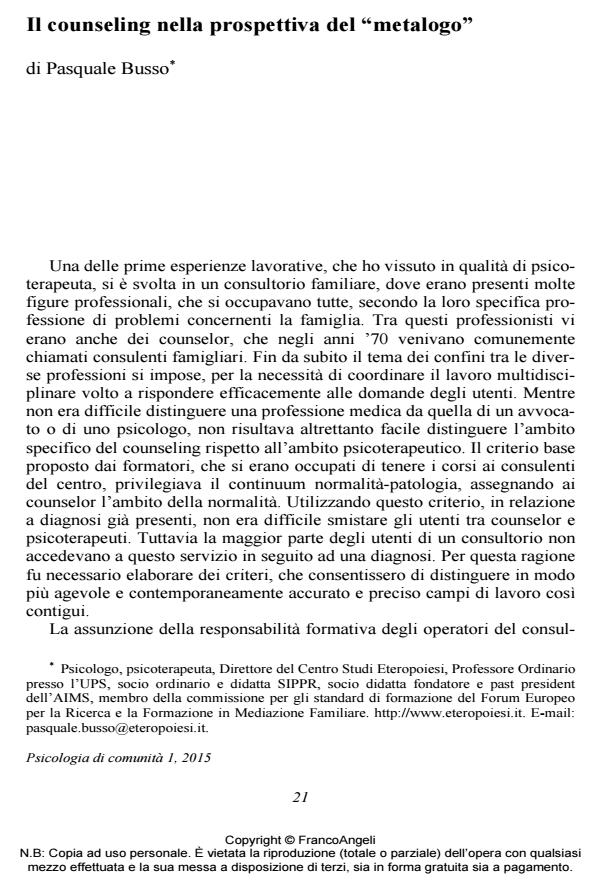Counseling in the perspective of the "metalogue"
Journal title PSICOLOGIA DI COMUNITA’
Author/s Pasquale Busso
Publishing Year 2015 Issue 2015/1 Language Italian
Pages 10 P. 21-30 File size 40 KB
DOI 10.3280/PSC2015-001003
DOI is like a bar code for intellectual property: to have more infomation
click here
Below, you can see the article first page
If you want to buy this article in PDF format, you can do it, following the instructions to buy download credits

FrancoAngeli is member of Publishers International Linking Association, Inc (PILA), a not-for-profit association which run the CrossRef service enabling links to and from online scholarly content.
In this article the author introduces a methodology that helps counselors understand the recognition process of the mutual roles professional and client co-build during the whole process of counseling. Starting from the analysis of a metalogue by Bateson, the article illustrates how to conduct an asymmetrical conversation, in which the client asks for help to find an answer to a personal problem. In this way, the definition of counseling enriches itself, because it values both the asymmetry of the roles and the complementarity of the parties towards the Language that speaks through them. The analysis of a case illustrates this methodology.
Keywords: Otherness, counselor, dialogue, metalogue, setting, recognition
- Abbagnano N. (1998). Storia della filosofia, Voll. I-XII. Novara: Istituto Geografico De Agostini, 2006.
- Bandler R., Grinder J. (1975). The Structure of Magic. Palo Alto: Science and Behavviour Books (trad. it.: La struttura della magia. Roma: Astrolabio, 1981).
- Bandler R., Grinder J. (1979). Forgs into Princes. Boston: Real People Press (trad. it.: La metamorfosi terapeutica. Principi di programmazione neurolinguistica. Roma: Astrolabio, 1980).
- Bandler R., Grinder J. (1982). Reframing. Neuro-Linguistic Programming and Transformation of Meaning. New York: Richard Bandler and John Grinder (trad. it.: La ristrutturazione. La programmazione neurolinguistica e la trasformazione del significato. Roma: Astrolabio, 1983).
- Bateson G. (1972). Steps to an Echology of Mind. Los Angeles: Chandler Publishing Company (trad. it.: Verso un’ecologia della mente. Milano: Adelphi, 1976).
- Bowen M. (1979). Dalla famiglia all’individuo. La differenziazione del sé nel sistema familiare. Roma: Astrolabio.
- Busso P. (1994). Identità professionale: un racconto in cerca di un narratore. I gruppi “metalogo”. Sistemi e Impresa, 9: 73-77.
- Busso P. (2001). La mediazione familiare sistemica: modello teorico e ambiti di applicazione. Maieutica, 15-16: 11-20.
- Busso P. (2004). Lotta e cooperazione. Percorsi per un’evoluzione ecologica del conflitto. Roma: Armando.
- Busso P. (2014). Metalogo: preliminari per una ricerca. Caleidoscopio Relazionale, n. 4, s.i.p.
- Busso P., Stradoni P. (1994). Gruppi metalogo e accesso al senso dell’identità personale. Animazione Sociale, 8/9: 73-77.
- Busso P., P. Stradoni (2007). Identità, diversità e gruppo di lavoro. Il metalogo nella mediazione istituzionale. Mediazione Familiare Sistemica, 5/6: 40-46.
- Busso P., Stradoni P. (2011). Sguardo retrospettivo sui mutamenti delle linee direttive della formazione sistemico-relazionale. Caleidoscopio Relazionale, 1: 22-28.
- Byng-Hall J. (1998). Rewriting Family Scripts. New York: Guilford Press (trad. it.: Le trame della famiglia. Milano: Raffaello Cortina).
- Cigoli V. (1997). Intrecci familiari. Realtà interiore e scenario relazionale. Milano: Raffaello Cortina.
- Gadamer H. (1960). Wahrheit und Methode: Grundzüge einer philosophischen Hermeneutik. Mohr: Tübingen (trad. it.: Verità e metodo. Milano: Bompiani, 1972).
- Heidegger (1959). Unterwegs zur Sprache. Pfullingen, Verlag Gunther Neske (trad. it.: In cammino verso il linguaggio. Milano: Mursia, 1990).
- Hellinger B., ten Hövel G. (1996). Hanerkennen, was ist. Geprache uber Verstrickung und Losung, Munchen: Kosel-Verlag GmbH&Co (trad. it. Riconoscere ciò che è. La forza rivelatrice delle costellazioni familiari. Milano: Feltrinelli, 2001).
- Montagano S., Pazzagli A. (1989). Il genogramma. Teatro di alchimie familiari.
- Milano: Franco Angeli. Morineau J (1998). L’esprit de la médiation. Paris: Erès (trad. it.: Lo spirito della mediazione, Milano: Franco Angeli, Milano, 2000). DOI: 10.1400/7655
- Pinsof W. M. (2002) (Ed.). Marriage in the 20th Century in Western Civilization: Trends, Research, Therapy, and Perspectives. Family Process, vol. 41, 2, Special issue.
- Ricoeur P. (1965). De l’interpretation. Essai sur Freud. Paris: Editions du Seuil (trad. it.: Dell’interpretazione. Saggio su Freud. Milano: Il saggiatore, 1967).
- Ricoeur P. (1990). Soi-meme comme un autre. Paris: Editions du Seuil (trad. it.: Sé come un altro. Milano: Jaca Book, 1993).
- Ricoeur P. (2004). Parcours de la reconnaissance. Paris: Editions du Seuil (trad. it.: Percorsi di riconoscimento. Milano: Raffaello Cortina, 2005).
- Scabini E., Cigoli V. (2000). Il famigliare. Legami, simboli e transizioni, Milano: Raffaello Cortina.
- Selvini Palazzoli M., Boscolo L., Cecchin G., Prata G. (1980), Ipotizzazione – Circolarità – Neutralità: tre direttive per la conduzione della seduta. Terapia Familiare, 7: 7-19. DOI 10.3280/TF2012-100010
- Tohey K. (1978). Il ki nella vita quotidiana. Genova: Erga.
- Watzlawick P. (1967). Pragmatics of Human Communication. A Study of Interacional Patterns, Pathologies, and Paradoxes. New York: W.W. Norton &
- Co. Inc (trad. it.: Pragmatica della comunicazione umana. Roma: Astrolabio, 1971). http://www.counsellingcncp.org/p/ass_documenti.htm
Pasquale Busso, Il counseling nella prospettiva del "metalogo" in "PSICOLOGIA DI COMUNITA’" 1/2015, pp 21-30, DOI: 10.3280/PSC2015-001003